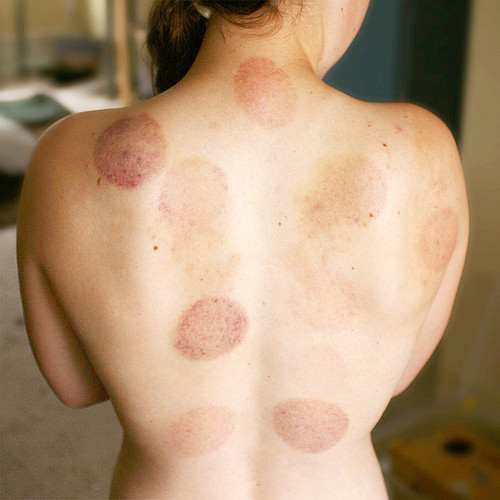Cupping is hip.
It used to be just weird, but thanks to movie stars and athletes—such as gold medal-winning athlete Michael Phelps—it has shed its old reputation.
I had my first cupping about 20 years ago when I went to a doctor of Chinese Medicine for acupuncture and did not like the needles.
“Ow! Don’t touch the needle after you put it in!” I’d say, rather loudly, as the doctor went around and wiggled the needles.
I had just survived the whole concept of allowing needles—okay, they’re only hairline thick—being inserted into my skin in any mysterious place the doctor thought they should be inserted, when she went back and started wiggling them.
“No wiggling!” I cried out.
That was when she suggested that maybe I would “enjoy” cupping more.
Was she kidding?
I would “enjoy” anything more.
I had about a dozen cupping treatments with her and then I didn’t get cupped anymore for a while—that is, until I got sick four years ago.
“Cupping raises qi, and anything that raises qi is good for you,” my current acupuncturist told me, by way of promising not to use needles when I went to her for treatment for a chronic illness.
I had always thought of cupping as a kind of step-child to acupuncture but, after having gained from its benefits over the past four years, I have moved it up in my estimation to treatment of choice.
When I became ill, I sought out cupping to help keep my lungs clear and along the way found that it not only improved my breathing to the extent that I could drop the drug-induced inhaler I had been using, but it also kept anxiety and depression at bay and improved the quality of my sleep.
There was also another benefit that I hadn’t realized until the other day when I happened to be getting cupped next to a former collegiate athlete. I’d asked her her reason for choosing cupping.
“It aids in muscle recovery,” she said.
“That must be why Michael Phelps uses it,” I mused. Then I read all the reasons why it’s part of the regular training of lots of athletes.
“Cupping is thought to draw blood to the affected area, reducing soreness and speeding healing of overworked muscles. Athletes who use it swear by it, saying it keeps them injury free and speeds recovery.” (New York Times)
After four years of regular cupping, my breathing problems having been virtually eliminated and I now rely on cupping to maintain a steady sense of wellbeing as well as to gain from its other numerous benefits.
“Cupping…can help remove toxins from the body and stimulate the flow of fresh blood, lymph, and Qi to the affected area and throughout the body. It often works wonders for patients with the flu, colds, coughs, back and muscle pain, poor circulation, anxiety, red itchy skin conditions (though cups are not applied to inflamed areas), allergies, fevers, aches and myriad other pains.” (Mind Body Green)
No doubt there are many kinds of bodywork-type treatments available, but I have found for the time (half an hour) and money (1/3 the cost of massages, at least where I live) nothing is as effective as cupping.
While the bruise-like marks are considered unsightly by some, they have never stopped me from getting cupped. The health benefits outweigh the visual effects too much for me to be concerned about cosmetics.
Besides, if Jennifer Anniston and Gwyneth Paltrow can go to black tie events with their cupping bruises showing, I can certainly let them show when I go to the grocery store. Not to mention the fact, that with my cupping bruises, I look like I am now part of an elite crowd, including a Gold Medal Winning Olympic Athlete.
Author: Carmelene Siani
Image: Amy Selleck/Flickr, Wikimedia Commons
Editor: Emily Bartran







Read 0 comments and reply